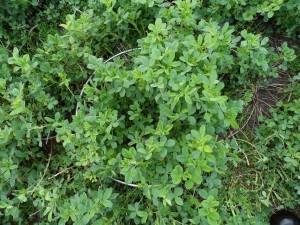This paddock of Torlesse is currently grazed by twin lambing ewes. Lucerne/Prairie Grass/Plantain, and Annual Ryegrass paddocks are also used for multiple bearing ewes to provide maximum nutrition in late pregnancy and lambing. Single bearing ewes are not grazed on lucerne, as this is better utilised for multiple lamb production. Fraser uses lucerne paddocks to lamb on, because at this time of year the animals come first, and good nutrition is essential. In order to do lamb growth rates of 400g/head/day, a good start is required, and this means feeding ewes well to ensure optimal milk production. This paddock has very good shelter, has easy access and visibility from the road, and is a great paddock to lamb in.
Although this is not strictly textbook late winter management of lucerne, as it has been shown that grazing lucerne in late winter can delay the onset of spring growth. The stocking rate is low (8 ewe/ha) to allow sheep to lamb without creating confusion at bonding time and to ensure that the lucerne stand is not grazed too hard, which should protect the lucerne growth points in the bottom of the sward. Stocking rate varies between paddocks with consideration of paddock shape and laming history taken into account. Within some paddocks the ewes will all congregate and lamb in one corner, in others they spread throughout the paddock. The bulk of the ewe flock lamb over 10 days.
As you can see in the photo (left) this paddock is looking great, free of weeds, and is on average 18-20 cm high.
The amount of worm casts in this paddock was amazing, and shows that there is a more than healthy population of earthworms in this paddock. Doug said this is also true for the rest of his mature lucerne stands. It is evidence that this is a healthy soil ecosystem in action!
The Highlander ewes were in extremely good condition coming into winter, and is testament to the prelamb feeding regime that Doug and Fraser use. As you can see in the slide show (Lambing onto Lucerne) below the ewes are lactating extremely well, and are more than able to support multiple lambs. The ewes are camping in this far corner of the paddock, and the lucerne height is lower here than the paddock average.
CLICK HERE TO SEE SLIDESHOW Lambing onto Lucerne
There does not seem to be an issue with ewes and bearings, even at this feeding regime at Bonavaree.
As soon as the bulk of lambs are born, mobs will be boxed and the rotational grazing is started. The aim is to have a 35 day return for the lucerne paddocks. Mobs are made up to match paddock size for each rotation.
We will revisit this paddock in the next couple of weeks.

